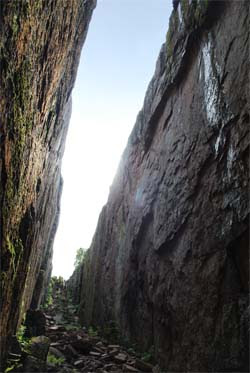When I was about 16 years old we went on a long walk in the forest 'Skulesogen' in north of Sweden.
It is one of the strongest spatial memories I have, especially the crevice in the mountain where we walked.
See, I grew up with these amazing tales by Swedish author Astrid Lindgren, and one of her characters, Ronja (who was the daughter of the master thief of the woods) lived in a mystic primeval forest.
'Ronia, the robber's daughter' was made into a movie, and the split in the mountain that separated the thief families was filmed in this very place. The actual physical place is called 'Slåttdalsskrevan'.
The crevice is a 200 meters long split in the mountain, with 10-storey high cliffs on either side. The narrow passage is humid and often misty. You are walking deep into the mountain, coming out on the other side, once again in a deep forest that encloses you.
After the walk through the crevice, you eventually reach a high place up on the cliffs.
A grand view over the waters, cliffs and forests spreads out for miles. My stepmother had to sit down because the mere presence of the view made her knees weak and she got a bit lightheaded by the hight. Wow, this is truly a beautiful place.
Nature does it best, and then architecture does it. The sublime in the narrow passage, almost like an underwater experience where you see the light surface far away on top of you, a streak of light. The physical presence of the cliffs making you feel like a tiny insect seeking their way in a difficult landscape and then the grandiose opening of the landscape, far beyond what you can comprehend.
Tours like these stay in my memory and inspire me in architecture, far more than any architecture blogg or built reality ever could. Because nature does it best and it is raw in it's approach.
The influence that Astrid Lindgren's tales have had, the film adaptations with dreamlike landscapes like 'The brothers lionheart' and 'Ronia, the robber's daughter' has made a lifelong impression on me.
If you get the opportunity to see them or show them to your kids, I think you should.
 |
| Photo: cyberphoto.se / Thomas Lövgren |
 |
| Photo: Naturvardsverket.se / Michael Engman / Engmanbild |
 |
| Photo: Skuleskogen.se / Carolina Hillerdal |
















